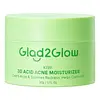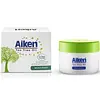What's inside
What's inside
 Key Ingredients
Key Ingredients

 Benefits
Benefits

 Concerns
Concerns

 Ingredients Side-by-side
Ingredients Side-by-side

Water
Skin ConditioningButylene Glycol
HumectantCyclopentasiloxane
EmollientCyclohexasiloxane
Emollient1,2-Hexanediol
Skin ConditioningHydroxyacetophenone
AntioxidantSalicylic Acid
MaskingCarbomer
Emulsion StabilisingSuccinic Acid
BufferingGlycerin
HumectantMandelic Acid
AntimicrobialAmmonium Acryloyldimethyltaurate/Vp Copolymer
Actinidia Deliciosa Fruit Extract
Skin ConditioningOpuntia Ficus-Indica Stem Extract
Skin ConditioningSophora Angustifolia Root Extract
Skin ConditioningOphiopogon Japonicus Root Extract
Skin ConditioningPentylene Glycol
Skin ConditioningDimethicone/Vinyl Dimethicone Crosspolymer
Skin ConditioningSodium Hydroxide
BufferingTrehalose
HumectantPortulaca Oleracea Extract
Skin ConditioningPPG-26-Buteth-26
Skin ConditioningDisodium EDTA
PEG-40 Hydrogenated Castor Oil
EmulsifyingMenthyl Lactate
MaskingAroma
Dipropylene Glycol
HumectantCI 19140
Cosmetic ColorantEthylhexylglycerin
Skin ConditioningCI 42090
Cosmetic ColorantWater, Butylene Glycol, Cyclopentasiloxane, Cyclohexasiloxane, 1,2-Hexanediol, Hydroxyacetophenone, Salicylic Acid, Carbomer, Succinic Acid, Glycerin, Mandelic Acid, Ammonium Acryloyldimethyltaurate/Vp Copolymer, Actinidia Deliciosa Fruit Extract, Opuntia Ficus-Indica Stem Extract, Sophora Angustifolia Root Extract, Ophiopogon Japonicus Root Extract, Pentylene Glycol, Dimethicone/Vinyl Dimethicone Crosspolymer, Sodium Hydroxide, Trehalose, Portulaca Oleracea Extract, PPG-26-Buteth-26, Disodium EDTA, PEG-40 Hydrogenated Castor Oil, Menthyl Lactate, Aroma, Dipropylene Glycol, CI 19140, Ethylhexylglycerin, CI 42090
Water
Skin ConditioningEthylhexyl Palmitate
EmollientGlycerin
HumectantDipropylene Glycol
HumectantDimethicone
EmollientCyclopentasiloxane
EmollientCyclohexasiloxane
EmollientPolyacrylate-13
Methyl Methacrylate Crosspolymer
Ethylhexyl Methoxycinnamate
UV AbsorberAllantoin
Skin ConditioningDimethicone Crosspolymer
Emulsion StabilisingMelaleuca Alternifolia Leaf Oil
AntioxidantCarbomer
Emulsion StabilisingBisabolol
MaskingSodium Hydroxide
BufferingDisodium EDTA
Biosaccharide Gum-1
HumectantButylene Glycol
HumectantGlycyrrhiza Glabra Root Extract
BleachingSalicylic Acid
MaskingParfum
MaskingPhenoxyethanol
PreservativeChlorphenesin
AntimicrobialWater, Ethylhexyl Palmitate, Glycerin, Dipropylene Glycol, Dimethicone, Cyclopentasiloxane, Cyclohexasiloxane, Polyacrylate-13, Methyl Methacrylate Crosspolymer, Ethylhexyl Methoxycinnamate, Allantoin, Dimethicone Crosspolymer, Melaleuca Alternifolia Leaf Oil, Carbomer, Bisabolol, Sodium Hydroxide, Disodium EDTA, Biosaccharide Gum-1, Butylene Glycol, Glycyrrhiza Glabra Root Extract, Salicylic Acid, Parfum, Phenoxyethanol, Chlorphenesin
 Reviews
Reviews

Ingredients Explained
These ingredients are found in both products.
Ingredients higher up in an ingredient list are typically present in a larger amount.
Butylene Glycol (or BG) is used within cosmetic products for a few different reasons:
Overall, Butylene Glycol is a safe and well-rounded ingredient that works well with other ingredients.
Though this ingredient works well with most skin types, some people with sensitive skin may experience a reaction such as allergic rashes, closed comedones, or itchiness.
Learn more about Butylene GlycolCarbomer is a polymer of acrylic acid. Its main role is to create a gel consistency.
A high amount of carbomer can cause pilling or balling up of products. Don't worry, most products contain 1% or less of carbomer.
Cyclohexasiloxane is a type of silicone more commonly known as D6. It is an emollient and solvent.
Cyclohexasiloxane is used to evenly distribute ingredients throughout the product. When applied to the skin, Cyclohexasiloxane evaporates and leaves behind a silky feel.
As an emollient, it can help the skin feel soft and hydrated. It is also used to reduce frizz in hair products.
Learn more about CyclohexasiloxaneCyclopentasiloxane, or D5, is a silicone used to improve texture of products and trap moisture.
D5 is considered lightweight and volatile. Volatile means it evaporates quickly after application. Once evaporated, D5 leaves a thin barrier that helps keep skin hydrated.
It is also an emollient. Emollients help soften the skin and prevent water loss. Silicones create a silky texture in products. D5 helps other ingredients become more spreadable.
Studies show D5 is safe to use in skincare products. We recommend speaking with a skincare professional if you have concerns.
Learn more about CyclopentasiloxaneDipropylene Glycol is a synthetically created humectant, stabilizer, and solvent.
This ingredient helps:
Dipropylene glycol is technically an alcohol, but it belongs to the glycol family (often considered part of the ‘good’ alcohols). This means it is hydrating and gentle on skin unlike drying solvent alcohols like denatured alcohol.
As a masking agent, Dipropylene Glycol can be used to cover the smell of other ingredients. However, it does not have a scent.
Studies show Dipropylene Glycol is considered safe to use in skincare.
Learn more about Dipropylene GlycolDisodium EDTA plays a role in making products more stable by aiding other preservatives.
It is a chelating agent, meaning it neutralizes metal ions that may be found in a product.
Disodium EDTA is a salt of edetic acid and is found to be safe in cosmetic ingredients.
Learn more about Disodium EDTAGlycerin is already naturally found in your skin. It helps moisturize and protect your skin.
A study from 2016 found glycerin to be more effective as a humectant than AHAs and hyaluronic acid.
As a humectant, it helps the skin stay hydrated by pulling moisture to your skin. The low molecular weight of glycerin allows it to pull moisture into the deeper layers of your skin.
Hydrated skin improves your skin barrier; Your skin barrier helps protect against irritants and bacteria.
Glycerin has also been found to have antimicrobial and antiviral properties. Due to these properties, glycerin is often used in wound and burn treatments.
In cosmetics, glycerin is usually derived from plants such as soybean or palm. However, it can also be sourced from animals, such as tallow or animal fat.
This ingredient is organic, colorless, odorless, and non-toxic.
Glycerin is the name for this ingredient in American English. British English uses Glycerol/Glycerine.
Learn more about GlycerinSalicylic Acid (also known as beta hydroxy acid or BHA) is a well-known ingredient for treating skin that struggles with acne and clogged pores. It exfoliates both the skin's surface and deep within the pores to help clear out buildup, control oil, and reduce inflammation.
Unlike AHAs (alpha hydroxy acids), salicylic acid is oil-soluble. This allows it to penetrate into pores which makes it especially effective for treating blackheads and preventing future breakouts.
Salicylic acid is also known for its soothing properties. It has a similar structure to aspirin and can calm inflamed or irritated skin, making it a good option for acne-prone skin that is also sensitive.
Concentrations of 0.5-2% are recognized by the U.S. FDA as an over-the-counter topical acne product.
It can cause irritation and/or dryness if one's skin already has a compromised moisture barrier, so it's best to focus on repairing that before introducing this ingredient into your routine.
While salicylic acid does not increase sun sensitivity, it’s still important to wear sunscreen daily to protect your skin.
If you are looking for the ingredient called BHA or Butylated Hydroxyanisole, click here.
Learn more about Salicylic AcidSodium Hydroxide is also known as lye or caustic soda. It is used to adjust the pH of products; many ingredients require a specific pH to be effective.
In small amounts, sodium hydroxide is considered safe to use. However, large amounts may cause chemical burns due to its high alkaline.
Your skin has a natural pH and acid mantle. This acid mantle helps prevent harmful bacteria from breaking through. The acid mantle also helps keep your skin hydrated.
"Alkaline" refers to a high pH level. A low pH level would be considered acidic.
Learn more about Sodium HydroxideWater. It's the most common cosmetic ingredient of all. You'll usually see it at the top of ingredient lists, meaning that it makes up the largest part of the product.
So why is it so popular? Water most often acts as a solvent - this means that it helps dissolve other ingredients into the formulation.
You'll also recognize water as that liquid we all need to stay alive. If you see this, drink a glass of water. Stay hydrated!
Learn more about Water